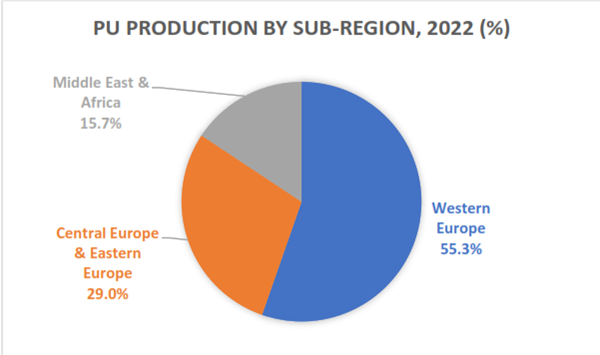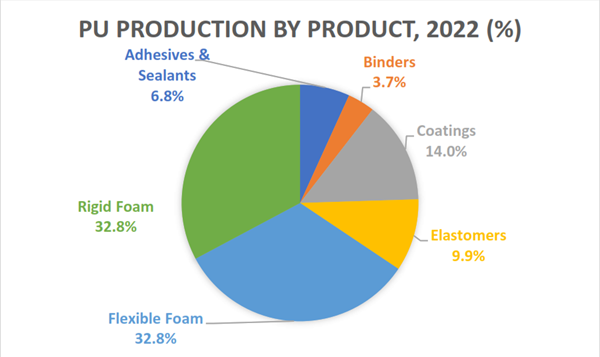Introducing the updated in-depth market report on Polyurethane Chemicals and Products in Europe, Middle East and Africa.
Geographical coverage of the report is as follows:
Western Europe (12 countries/regions)
Austria, Benelux, France, Germany, Greece, Ireland, Italy, Nordic Region, Portugal, Spain, Switzerland, United Kingdom
Eastern Europe (10 countries/regions)
Czech Republic, CIS, Hungary, Other (Baltic States, Romania, Bulgaria), Poland, Russian Federation, Slovak Republic, Slovenia, Turkey
Middle East and Africa (10 countries/regions)
Iran, Levant, North Africa, Other GCC, Other MEA, Saudi Arabia, South Africa, UAE, West Africa
Raw material coverage:
- Acrylic Polyol
- MDI (MMDI & PMDI)
- TDI
- Specialty Isocyanates
- Standard Polyether Polyol
- Polyether Graft Copolymer Polyol
- Polyester Polyol
- PTHF Polyol
This publication is presented in eight volumes, with data tables detailing the production of polyurethane products and related raw material consumption, plus summaries of key market trends and drivers.
For each country, production data is provided for the following end-use market sectors:
Flexible Foam
Polyether Slabstock, HR/CMHR Slabstock, Polyester Slabstock, Viscoelastic Foam, Moulded Foam for Automotive Seating, Moulded Foam for Commercial Vehicles, Other Transport Foam, Carpet Backing & NVH, Furniture Components, Semi-rigid Foam, Integral Skin Foam.
Further regional segmentation for slabstock into furniture component foam, bedding foam, vehicle foam, recycled foam.
Rigid Foam
Rigid-Faced Sandwich Panels (Continuous & Discontinuous), Flexible-Faced Panels, Slabstock, Sprayed Foam (SPF), Commercial Refrigeration, Domestic Refrigeration, Water heaters, OneComponent Foam (OCF), Moulded Rigid Foam, Pipe-inPipe Insulation, Other.
Coatings
Architectural Coatings (interior/exterior), Auto OEM, Auto Refinish, Commercial Vehicles, Industrial Coatings, Maintenance Coatings, Marine Coatings, Plastic (nonautomotive) Coatings, Roof, Tank & Deck Coatings, Textile & Leather Coatings, Wood/Furniture Coatings, Other.
Adhesives
Automotive, Construction, Flexible Packaging, Footwear, General Assembly, Other.
Sealants
Auto Direct Glazing, Construction, Insulated Glazing, Other Transport.
Elastomers
Cast Elastomers, Fibres/Spandex, Microcellular Footwear, RIM/RRIM, Technical Microcellular, TPU, Synthetic Leather Resin, Other.
Binders
Forest Products, Foundry Core, Rubber Crumb, Other.
New for 2023: Further regional segmentation for PUR/PIR for relevant rigid foam products.
Table of Contents
Volume 1 - Raw Materials1. Introduction
Samples

LOADING...
Executive Summary
The market for polyurethanes has experienced several challenging years in the EMEA region. Production declined by 6.4% in 2020 but recovered somewhat in 2021 with 3.1% growth. Economic and political issues, not least the Russia-Ukraine conflict, caused a decline in production in 2022. Overall, output dropped by 5.2% in the EMEA region, and a further decline of 1.7% is anticipated for 2023.
Pre-pandemic production is not expected to be regained until the end of the forecast period, in 2027. Growth rates should return to 2-3% p.a. by 2024, if the situation does not worsen from the time of publication.
Historically, flexible foam has been the largest end-use segment, but due to slow growth rates in recent years, rigid foam is now the largest market for PU products in EMEA. Both product types together represent 66% of the overall market. Binders account for the smallest share of PU production.
The total production of polyurethane products in the EMEA region was 6.09 million tonnes in 2022, representing a decline of 5.2%. There were many contributing factors, including the conflict in Ukraine, energy crisis, high inflation, rising interest rates and weakening confidence. The situation for 2023 remains highly fluid and uncertain.
All regions experienced a decline in 2022, with the exception of the Middle East. The poorest performance came in Eastern Europe, which was predominantly due to the severe fall in production in Russia and the CIS region. The fallout from the Russia-Ukraine conflict also affected Central Europe. The Middle East was by far the best performing region, and it is here that much of the opportunity for further growth resides. Polyol prices increased in the European market during the first quarter of 2022, supported by strong demand from a variety of downstream industries. The expanding automotive sector increased demand for flexible polyurethane foam, which in turn boosted polyol consumption.
Dampened demand caused polyol prices to decrease through the middle of 2022, and many European producers cut their operating rates amid rising inflation and high energy prices.
The development of renewable polyols will heavily depend on changes in government legislation or subsidies. It will, however, be difficult for producers to stay competitive. Without legislative pressure market penetration will remain limited in the short term.
Flexible Foam
Total EMEA production of polyurethane flexible foam was just over 2 million tonnes in 2022, a decrease of 6.6% compared to the previous year. After a small rebound in 2021, flexible foam production contracted significantly in 2022 amid falling consumer demand for comfort foams, previous overstocking activity, and despite an uptick in automotive production.
The first half of 2022 was fairly positive for flexible foam, but the second half showed a distinct collapse in demand. This was among the worst performances of all PU products in 2022. The technical foam segments did perform somewhat better than the comfort foams.
The flexible foam market in EMEA is relatively mature. Western Europe is the largest producer by some margin, followed by Eastern and then Central Europe, with the latter two regions’ furniture industries being very important (notably Poland and Turkey). Africa and the Middle East also produce significant quantities of flexible slabstock since the production process is relatively simple.
2022 was influenced by the impact of the Russia-Ukraine war. High inflation rates and rising interest rates caused a decrease in consumer spending power and confidence. Furthermore, the COVID-19 pandemic had already brought forward many discretionary replacements of consumer items such as mattresses and sofas as people invested in their homes when they were unable to travel or socialise.
Rigid Foam
PU rigid foam production in EMEA declined by 4.7% in 2022 to reach 2.0 million tonnes. Rigid foam was the second largest polyurethane segment in 2022, just behind flexible foam. The decline in rigid foam production in 2022 was not as steep as flexible foam, elastomers or binders.
Western Europe accounts for the largest share of rigid foam production in the region, followed by Eastern Europe. Africa is the smallest producing region.
By sub-region, there was growth in the Middle East and Africa in 2022, thanks to their buoyant construction sectors, but declines elsewhere. The drop was particularly significant in Eastern Europe due to the poor situation in Russia and Ukraine.
The construction sector covers over 80% of PU rigid foam used in the EMEA region, with additional demand coming from the cold chain and refrigeration industries. By product type, the single largest category is rigid-faced panels, followed by flexible-faced panels, refrigeration foam and OCF. All categories saw a decline in 2022, but SPF and refrigeration foam fared better than the other products.
CASE Applications
The EMEA region produced 859,000 tonnes of polyurethane coatings in 2022, representing a decrease of 2.9% compared to the previous year. The industry rebounded a little in 2021 after the effects of the pandemic subsided, but 2022 was another difficult year. Despite the decline, however, the industry performed somewhat better than the foam categories.
The biggest end-use categories in the region for PU coatings are wood and furniture coatings, industrial coatings, and maintenance coatings. Transport is also a large sector if all uses, such as auto OEM, auto refinish, commercial vehicle and marine coatings, are taken together. The coatings market for automotive applications experienced growth in 2022 after several difficult years.
The EMEA region produced 414,000 tonnes of polyurethane adhesives and sealants in 2022, representing a decline of 2.4% compared to the previous year. Adhesives represent 74% of production, and sealants for the remaining 26%. Although production declined, the segment fared somewhat better than the foam products.
Flexible packaging adhesives represent the largest product category within PU adhesives and sealants, accounting for ~31% of production, followed by construction adhesives with 26%. All other categories have less than 10% share of production.
The best performing categories in 2022 were auto direct glazing sealants, automotive sealants and transport sealants. This was because the automotive industry started to pick up momentum after several very difficult years.
Production of polyurethane elastomers in the EMEA region stood at approximately 579,000 tonnes in 2022, which reflects a decrease of 6% compared to 2021. The market is expected to decline again in 2023, albeit at a slower rate, then pick up again from 2024 onwards. There was a decline in all segments in 2022 with the exception of technical microcellular elastomers, which benefitted from the uptick in the automotive sector. Footwear elastomers represent by far the largest end-use segment, at 210,000 tonnes of production, followed by TPU and cast elastomers. Germany, Turkey and Italy are the countries with the highest production output in EMEA
Binders
Production of polyurethane binders in the EMEA region declined by 7.5% in 2022 after modest growth in 2021. There were double-digit declines in Central and Eastern Europe as the Russia-Ukraine conflict caused supply chain uncertainties and weakened consumer confidence. Africa was static, and there was growth in the Middle East to match the growing construction activity.
The largest product segment is forest product binders, which are used to produce woodbased panels such as OSB. Smaller quantities are produced for rubber crumb, foundry core and assorted other binder applications.
The greatest decline in 2022 was in forest product binders, as a lot of these are produced in Russia. Potential restrictions on the use of urea formaldehyde binders may propel demand in future years.
Companies Mentioned (Partial List)
A selection of companies mentioned in this report includes, but is not limited to:
- Basf Polyurethanes
- Covestro
- Dow Chemical
- Huntsman Polyurethanes
- Borsodchem Zrt
- Royal Dutch Shell plc
Methodology
Information provided in these reports are based on existing in-house data and an extensive programme of interviews with leading product manufacturers, trade associations, distributors and raw materials producers involved with the specific market researched. These interviews are conducted within the 3-6 months leading up to the publication of the study, with the duration of the research programme and the number of interviews completed depending on the scope of the study. The analyst publishes both regional and global reports, and in most cases, the interviews are conducted in the native language of the individual respondents.
In addition, published data and statistics are also reviewed in order to produce as accurate figures as possible for size of markets studied. Market forecasts are based upon industry and economic forecasts as well as upon other relevant commercial and technical issues likely to affect individual market sectors and products, as well as the interviews conducted for the study.

LOADING...










